5 Reasons Bath Fans Have Such Poor Air Flow
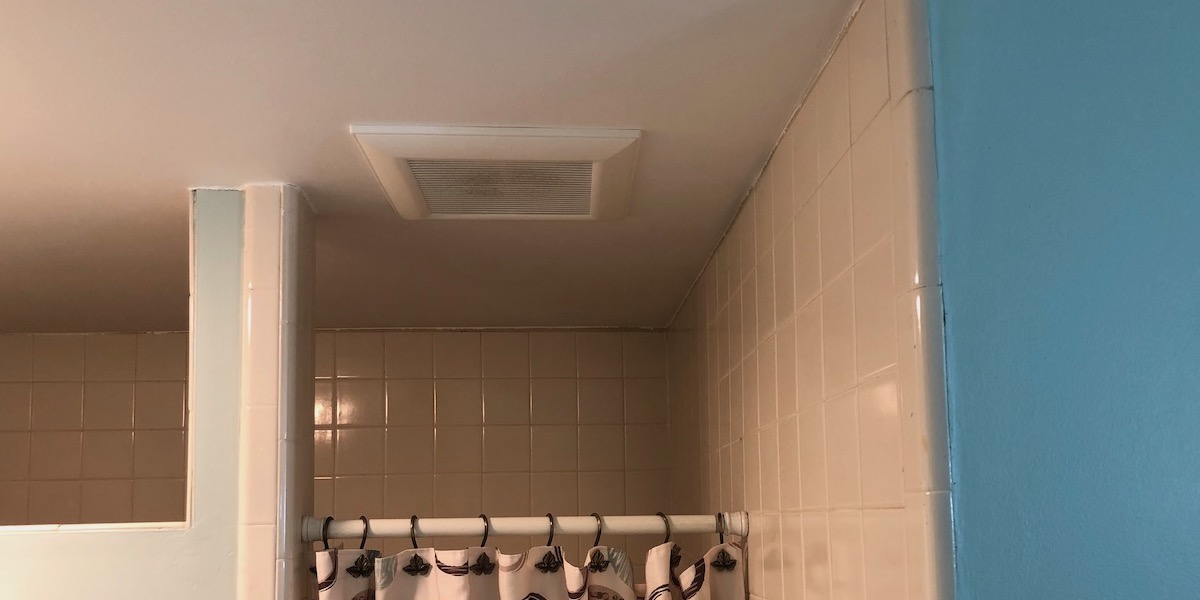
I’ve spent a lot of time in attics looking at problems with insulation, air sealing, HVAC systems, and ductwork. I’ve also seen why so many bathroom ventilation fans don’t move much air. A typical bath fan is rated to move 50 cubic feet per minute of air when it’s operating, but most actually move about half of their rated air flow. Here are 5 reasons why this happens.
1. No duct, fan blowing into insulation
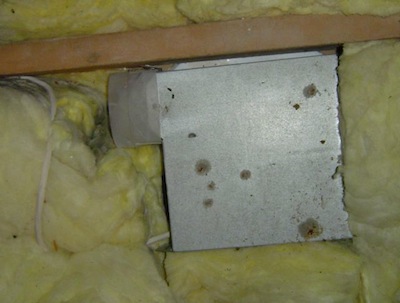
As you can see in the photo above, there’s no duct attached to this fan. Usually, no duct means better air flow. The air doesn’t go where you’d like it to, but it flows easily. Except when it doesn’t, of course, as in in this case. Here, instead of blowing into an open duct or open space, the air hits compressed fiberglass insulation. Bam! Not much comes through. You can see from the dark spot on the fiberglass that some air does escape, but it won’t be much here.
2. Duct terminates at obstruction
The fan shown below does have a duct.
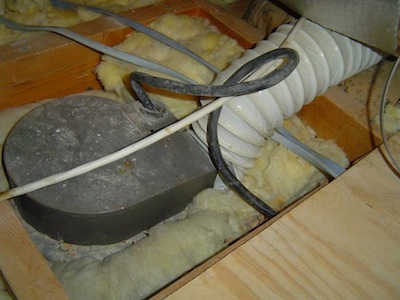
But let’s follow that duct and see where it takes the air. First, it goes over a ceiling joist in the attic.
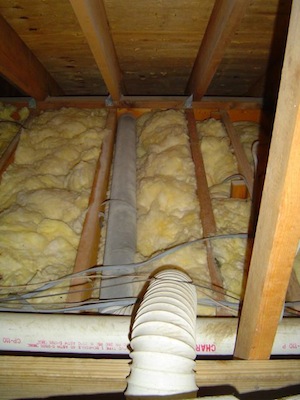
Then it goes into a piece of rigid duct that goes right up to another ceiling joist.

There might be a quarter inch gap between the duct and the joist, not enough to let much air out. (Even with a bigger gap, though, you don’t want to vent your bath fans into the attic because you need to get the moisture out of the house completely.)
That duct needs to go all the way to the outside to do its job. I’m sure the installer just took his lunch break and will be back any minute to finish this up. Right? Oh, wait that duct was installed decades ago. Maybe he’s not coming back.
3. Duct too long
Here’s another fan with a duct that starts off OK.

But when we follow it…
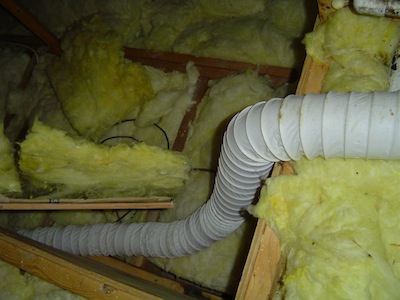
…and keep following…

…just as we get tired trying to find out how far this thing goes, the air inside gets too tired to make it all the way to the end. The wire spiral that gives flex duct its round shape also gives it extra friction, especially when it’s not pulled tight, as you see here, so the air flow just peters out.
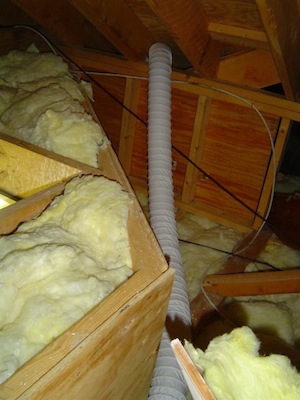
4. Crazy turns with flex duct
I don’t know why this happens so frequently, but it seems that nearly half of the bath fans I see roughed-in at predrywall inspections are mounted so that the duct immediately makes a 180 degree turn on its way to the outside.
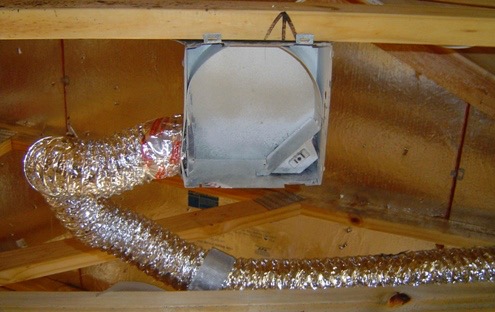
As stated before, flex duct has a high friction rate, and it’s easy for air not to have the oomph to make it through imperfect installations. Not only does it have to make that turn, which reduces air flow, but the duct isn’t pulled tight, which reduces it even further. They’ll be lucky to get half the rated flow out of that fan. (But, hey, they have a radiant barrier!) If the duct is supposed to be going one way, the installer needs to install the fan housing with the duct opening facing that way.
5. Bathroom door closed
Unless your bathroom has a large gap between the bottom of the door and the floor or some other way for air to get into the bathroom, the bath fan will quickly be pulling against a pressure that makes it difficult to move much air. Every cubic foot (or cubic meter for those of you outside the US) of air that the fan removes from the bathroom must be made up by a cubic foot (or cubic meter) of air coming in. When those cubic feet get hard to pull in, they aren’t going out as easily either.
What this means is that you need to run the bath fan with the door open for a while to get a decent amount of air exchange. Don’t just turn the fan off when you leave because it probably hasn’t done enough yet. There are plenty of nice timer switches available for this purpose.
These five problems aren’t the only ways that your bath fan’s air flow might be compromised, of course. People who work on houses are a creative lot. What have you seen?
This Post Has 34 Comments
Comments are closed.

Good topic. I always like to
Good topic. I always like to tell people when laying out the ducts in craziest possible manner to imagine that they were soldiers who need to crawl throug these ducts to the end, and figure out which layout will exhaust them more.
Whenever you look for the flow rating of bathroom fans, do not forget to look at what pressure conditions they were rated for. If your duct gets too curvy your pressure losses will definitely overcome the rated pressure for the fan (might be good to post some article about fan system curves in a future to explain this concept in more details). And one thing not to forget. Keep your ducts and grilles clean to have a good runnig power of your fan (the same as with your car).
It is often considered a
It is often considered a gospel that these exhaust fans remove moisture from the house. But quite a number of houses are in a humid climate where outdoor dew point is higher than the indoor dew point. Even when looking at the air that fan removes. Just wanted to question that conventional wisdom.
We have had luck in solving
We have had luck in solving problem # 4 by having the HVAC contractor install the fan housing rather than the electrician which is customary. The electrician is more concerned with the mounting fins than efficient duct flow.
Danko:
Danko: Great points! I love your analogy of soldiers crawling through the ducts.
M. Johnson: Yes, that’s absolutely true. Even on a muggy day in Houston, though, bathrooms can have a higher dew point than outside – at first. Once the fog is gone from the bathroom in periods of high dew point, turn off the fan.
Bill H.: That’s good to hear. I’ve seen them installed poorly by both trades, but you’re right that it really should be the HVAC contractor’s job because they’re more likely to understand air flow.
Thanks Allison. I am also
Thanks Allison. I am also glad to see that E.T. took a position of ductwork inspector on the first picture above. :). Even the aliens realized importance of energy efficiency and healty homes.
Here are my “Keys”
Here are my “Keys” to get them to pass:
Use next highest rated airflow for the rate you are trying to achieve.
Use a metal elbow as is takes off out of the fan. Use a 5-6″ duct, preferably insulated and run it “straight” up through the roof if possible.
It is AMAZING how quiet they run when installed like that and they perform as expected.
My bath fans were installed
My bath fans were installed as picture #1 above. A quick way to catch a blocked duct w/o going into the attic is put a piece of paper over the running fan and see it it can hold it.
When I put new fans in I of course redid the ductwork. The main bath has a 4’long 4″ rigid duct going to a 3 blade “dryer” type outlet in the sidewall. Minimal back pressure.
The master bath has a 4″ to 3″ reducer then 5′ of 3″ ductwork with a long 45 degree elbow. Airflow at exit outside is strong. I figured is was less back pressure than 15′ of 4″ duct with a 90 elbow and a roof cap. The way it’s hooked up the vent is pointing DOWNWARDS so condensation doesn’t fill up in the vent.
Dryer vents are even worse than bath fan vents, but that’s another article.
Danko: Ha!
Danko: Ha! Yeah, I caught that alien lurking in an attic about 3 years ago.
Chris C.: Using metal elbows at turns is a great idea in any duct system. Putting in a bigger fan can overcome duct problems if it’s too difficult or expensive to fix the duct, but fixing the duct is always where I’d start. Insulating bath fan ducts is a great idea, too, to prevent condensation inside the duct in cooler weather.
Bob: Sounds like you’ve got your fans done right now. And yes, dryer ducts are often worse. I wrote a couple of articles about this last year:
An Easy to Fix Air Flow Problem That Can Save Energy – and Your Life
4 Products for Enhancing Air Flow in Dryer Vents
#6 – the fan hasn’t been
#6 – the fan hasn’t been cleaned in years, leading to dust and lint buildup. not only majorly disgusting but also potentially dangerous.
Having the fan exhaust into
Having the fan exhaust into the soffit doesn’t help much, as the ventilated soffit is the intake for the ventilated attic system. The humid air is sucked back in to the attic. As for the humidity outside being greater, that is the reason for installing fresh air ventilation directly into the return side of the AC, bringing in clean, dehumidified air.
Mike E.:
Mike E.: That’s another good one. Air flow can be restricted on the front end of the fan, too.
Walt S.: That really long run in #3 above does exactly that – dumps what little air makes it there into the soffit. As you say, if the soffit vents are doing their job, air is coming up into the attic there, so the air from the duct gets pulled right back into the attic. And yes, positive pressure ventilation systems can help with the dew point issue.
Of course, the root of the
Of course, the root of the problem is that the folks supervising the workers often don’t know what they’re doing.
#7 ventless fan with deodorizer tablet
@Mark: your point is exactly why “exhaust-only” ventilation is a bad idea in humid climate zones.
@Allison: it’s helpful to know how much undercut is needed so we don’t go too crazy with this — 1/2 square inch per CFM. So a 50 CFM fan requires a 3/4″ to 1″ undercut, depending on door width.
David B.:
David B.: Ah, yes, the fan that’s ventless by design. When installed in the kitchen over the range, they’re called forehead greasers.
Thanks for raising the issue of how much undercut a bathroom door needs. Building Americas has a nice article about this showing the results of an FSEC research study that coincides with your 0.5″/cfm recommendation. You can read it here: Return Air Pathway Study. Scroll down to the table that shows the ratio of cfm to area for different configurations to find the numbers.
My favorite is the magic
My favorite is the magic connection. Where the contractor extends the flexible duct 15+ feet straight up and obviously over time it tears.
Great big undercuts in the
Great big undercuts in the bathroom? Don’t forget privacy concerns. Shouldn’t a modest undercut along with the HVAC supply vent in bathrooms supply sufficient exhaust vent makeup air?
Of course, a tiny undercut would be a problem when the HVAC system is running, the exhaust vent is off and the door is closed. What solutions are folks using for the bathroom return path problem?
Good stuff!!
Good stuff!!
Thanks,
I’m surprised that no one
I’m surprised that no one raised the issue of Energy Star approved exhaust fans. In addition to being more energy efficient, they exceed the current minimum code-required air flow and are generally very quiet. Also, depending on your locality’s building codes (if you have any), the IRC has for years restricted the maximum duct run to 35 ft or less (or the manufacturers recommendations) depending on the number and type of elbows in the line. Thought you would like to know since no one mentioned these items.
Great stuff!
Great stuff!
The rule of thumb for sizing bath fans is 8 ACH (actual flow)of the bathroom volume.
A standard 5×8 bath with 8′ ceilings would therfore be 320 cu ft x 8 ach = 2560 cuft/hr or 43 cfm measured flow at a minimum.
I think I now understand my
I think I now understand my situation in our bathroom which I’ve been trying to solve in my own but I might be calling a home service to fix it for me. Great post and excellent blog
The biggest problem Ii se is
The biggest problem Ii se is the use of flexible duct. This will disturb the airflow more than anything.
Just some more info.:
Just some more info.: Regarding undercut doors as return air pathways, Section 2.8 of the HVAC System Quality Installation Rater Checklist, Energy Star version 3, (Rev. 05)requires one square inch of free area opening per 1 cfm of supply air. ACCA Manual D (3rd edition),Appendix 1, para. A1-2 and table A1-2 show a prety nifty table for sizing undercuts at a 300 fpm velocity. The intention is to discourage the practice. Realistically though, undercutting bathroom doors is probably the only viable option for these typically small rooms that have the doors open most of the time anyway.
I just got a new fan
I just got a new fan installed and it seems that it is blowing air out as well as sucking it in. Is it normal or do I need to get the contractor back in? Thanks!
BTW, yes, it is vented.
Masha: No,
Masha: No, bath fans should NOT be blowing air into the bathroom. It sounds like maybe the fan flow is hitting an obstruction that’s deflecting part of the air back into the bathroom. Get it checked out.
Allison,
Allison,
A thousand thanks for doing this blog. What an amazing resource. On Facebook recently you posted a photo from the Roxul plant in Ontario. Can we look forward to something about mineral wool?
I just found this old discussion through a link on your recent Energy Star 3 article. Obviously ceiling-mounted bath fans can have problems with crazy flex ducts. Is this a reason possibly to go with a simple wall-mounted fan (on an exterior wall, of course), like the Panasonic WhisperWall? I assume that is not going to lose a lot of its cfm rating. Or does that carry energy problems of its own?
Please Help, I have three
Please Help, I have three vents, two in the bathrm. and one in the laungry rm. They work But they do not pull the air out the rm so they are not functional. The house has no basement or attic. What can be done to fix this problem. Thanks
Gordon T.:
Gordon T.: I seem to recall responding to your question about wall-mounted fans somewhere (LinkedIn) and probably said they’re OK if they don’t go through a building envelope wall. I did write something about mineral wool this summer. Did you see it?
Green Curmudgeons, Architects, and Outlawing Batt Insulation
Barbara W.: You’ll have to have someone determine why they’re not pulling air out of those rooms. It could be the fan, the duct, the wall cap, or any combination. Why do you have a fan in the laundry room, though? That’s a bit unusual and could cause problems, depending on what else is in there.
One more scenario to consider
One more scenario to consider: ducts could be perfect to outdoors with no obstructions, plenty of makeup air is available, and the poor fan still not move much air. How?
That cheap little plastic damper on the discharge of the fan has been stuck closed from installation due to drywall texture or paint overspray. Seen that happen a lot.
Great info. Wonder if anyone
Great info. Wonder if anyone can help with a problem I’m having: I’m replacing a small bathroom fan which didn’t work well with a higher cfm version. The old ductwork is about 5′ and straight, but it’s only 3″ around while the new fan has a 6″ opening with a 6″ to 4″ adapter. Is it safe to put a 4″ to 3″ adapter on and use the existing duct or do I need to run new 4″ ducting? It’s a small bathroom. Thanks!
Run new 4 inch duct and a new
Run new 4 inch duct and a new 4 inch vent. Insulate the duct.
I just installed a 135 CFM in
I just installed a 135 CFM in-line ventilation fan for my 85 sq ft bathroom, this fan replaced a 45 CFM ceiling mount fan and light. I removed the 45 CFM fan & motor from the housing and left the ceiling cover and light in place in spliced the in-line fan in the duct work in the attic. I have a 1″ undercut at the bottom of the bathroom door and the duct has one elbow at at the ceiling vent housing and then runs about 9′ straight out the back of the house. I figured I would have no steam issues in the bathroom with this set up, however, I turned the shower on, let it run 20 minutes, walked in the bathroom and it was completely steamed up, walls and ceiling dripping with moisture. The duct is clear, no obstructions..
What could the problem be? I’m really at a loss and frustrated, I’m tired of having to wipe the walls down after every shower!
Can i drop down a foot to
Can i drop down a foot to exit the room to outside,I am in the basement and do not want to drill through the header
I may have missed it, but the
I may have missed it, but the most common reason I find in my area is that people, have installed replacement motors and they have them in backward. The fan blades spin the wrong direction and no air is pulled out of the bathroom.
What about when the moisture
What about when the moisture is high in the air outside anyway, such as on a rainy day the moisture levels outside could be at 96% humidity +. And if the soffits are open, isn’t this humid air being exchanged into the attic, especially if there’s a gable or ridge vent pulling the soffit air through? Isn’t having a bath fan going directly into the attic doing the same thing, putting humid air into the attic? Or, even if the bath fan was vented through a soffit, that is separated by 5 feet on either side away from other soffits, shouldn’t this solve bath fan air going into the attic?
@John, even though RH may be
@John, even though RH may be higher outside than inside, even 100%, the dew point (which is what matters) of a bath exhaust is usually much higher than the outside dew point, especially in winter. The problem is when wood surfaces in the attic are colder than the exhaust air dew point… you get condensation.
Exhausting a bath fan through a soffit as you describe may be OK as long as there’s no possibility of feedback.